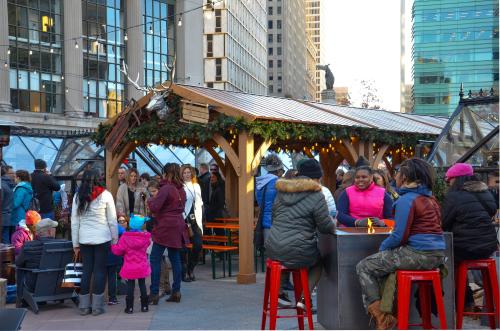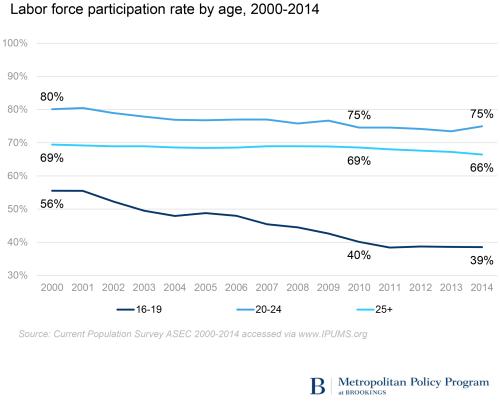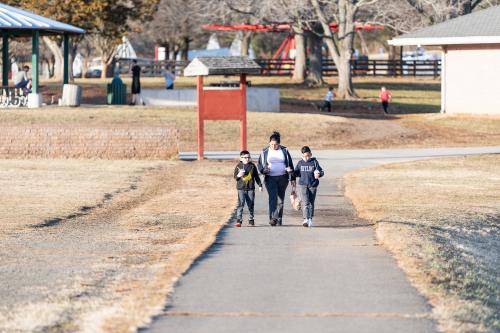Newly released Census Bureau statistics show that, despite the growth in large metropolitan areas driven by racial minorities, the neighborhoods in which whites live have become only modestly more diverse since the 2000 Census. These new statistics, from the 2011–2015 American Community Survey, also update the neighborhood racial segregation measures for blacks and Hispanics.
“Less white” white neighborhoods
Since 2000, racial minorities—blacks, Hispanics, Asians, and other non-white groups—have comprised 95 percent of U.S. population growth and 98 percent of growth in the nation’s 100 largest metropolitan areas. Still, in these areas, which saw both high minority growth and increased minority dispersion to the suburbs, the average white resident lives in a neighborhood that has become only modestly more diverse and remains markedly “whiter” than its respective metropolitan area population.
This can be seen in Figure 1, which shows the racial make-up of these combined large metropolitan areas, as well as the racial make-up of neighborhoods where the average white resident lives.

Sixty-four percent of the population in large metropolitan areas was white in 2000, a figure that dropped to 56 percent for 2011–2015. However, the neighborhood of the average white resident in these metropolitan areas continues to remain “whiter”—with that white share declining from 79 percent to 72 percent, and showing modest gains in the shares of other racial groups.
For whites residing outside of large metropolitan areas, neighborhoods are even whiter and the changes were even smaller. That is, white residents in small metropolitan areas live in neighborhoods that are, on average, 80 percent white, down from 84 percent in 2000. Whites residing outside of metropolitan areas live in neighborhoods that are 85 percent white, down from 88 percent in 2000.
The modestly less-white character of neighborhoods where whites reside is not unique to just a few individual metropolitan areas. It is occurring, to some extent, in all 100 large metropolitan areas, and is especially noticeable in the 51 major metropolitan areas with populations exceeding one million (see Table 1).
To be sure, there is variation across metropolitan areas in just how “white” these white residents’ neighborhoods already were in 2000. For example, whites living in places with large minority populations (such as New York and Los Angeles) live in neighborhoods that are noticeably less white than white residents who reside in less diverse metropolitan areas (e.g., Pittsburgh and Minneapolis-St Paul).

In a handful of areas, including Las Vegas and Orlando, minority population growth was extraordinarily large. In these metro areas, “white” neighborhoods became markedly more diverse between 2000 and 2011–2015.
But even in these areas (as in most), whites live in neighborhoods that are far whiter than the metropolitan area as a whole. This relates to the continued high segregation levels of blacks, Hispanics, and other racial minorities.
Black and Hispanic neighborhood segregation
The new Census statistics also provide measures of neighborhood segregation for blacks compared with white residents. There continues to be wide variation in segregation among the nation’s 51 major metropolitan areas (see Table 2). Metropolitan Milwaukee shows the highest black-white segregation, with an index of 81—meaning that 81 percent of blacks would have to change neighborhoods to be distributed equally with whites.
Almost five decades after the 1968 Fair Housing Act was enacted, seven of these major metropolitan areas—including Milwaukee, New York, Chicago, Detroit, Cleveland, Buffalo, and St. Louis—show segregation indices exceeding 70, which is considered a high level of segregation. These slower-growing regions have shown modest or negative growth in their black populations in recent decades. And despite recent black suburbanization, which lowered their segregation rates from extremely high levels, they remain (as in 2000) the most highly segregated areas of the country.
Among major metropolitan areas, Las Vegas registers the lowest level of segregation, at 40. As with other metro areas with sub-50 segregation scores, Las Vegas experienced marked gains in its black and other minority populations over the years, opening the door for development of new housing tracts since older, segregated neighborhoods were already established. However, several of these areas—including Phoenix, Virginia Beach, and Raleigh—registered slight increases in black-white segregation since 2000.
While post-Civil Rights Era enforcement and population shifts have lowered black-white segregation from the extremely ghettoized patterns seen prior to 1970, segregation declines since 2000 have been relatively modest. The average segregation score among the major metropolitan areas declined only from 63 to 60.
Hispanic-white segregation also varies across metropolitan areas, but at generally lower levels than for blacks. New York and Los Angeles lead all major metropolitan areas with segregation indices of 61. Other areas with Hispanic-white segregation levels of at least 50 include those with large Hispanic populations, such as Miami, Chicago, Houston, and Dallas. Still, each of these areas showed modest segregation declines since 2000.
Jacksonville registers the lowest Hispanic-white segregation index among major metropolitan areas, but those areas with the lowest segregation levels (including Portland, Seattle, Virginia Beach, and St. Louis) showed segregation increases since 2000. As with many of the 22 major metropolitan areas that exhibited increased Hispanic-white segregation, these areas experienced marked recent increases to their relatively small Hispanic populations. When averaged across all major areas, Hispanic-white segregation levels increased from 47 to 48 between 2000 and 2011–2015.
America’s diversity explosion continues to power demographic change in all parts of the country, especially in large metropolitan areas, and racial minorities continue to spread from cities to suburbs and to new metropolitan areas. Still, neighborhood integration is not keeping pace with the declines that occurred during the decades that immediately followed the Civil Rights Era. Whites continue to reside in predominantly white neighborhoods, even in large, highly diverse metropolitan areas. And both blacks and Hispanics continue to be most segregated in areas that contain large numbers of these groups, and where concentrated poverty has risen. While macro demography broadly shapes our destiny, these new numbers indicate that additional forces must be involved to achieve more fully integrated living at the local level.







Commentary
White neighborhoods get modestly more diverse, new census data show
December 13, 2016